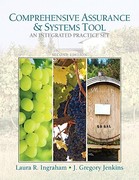I have attached the problems.
E7-2 Preparing production budget and direct materials budget The sales department of P. Gillen Manufacturing Company has forecast sales in March to be 20,000 units. Additional Information follows: Finished goods inventory, march 1 3,000 units Finished goods inventory required, march 31 1,000 units Materials used in production: Inventory March 1 A (one gallon per unit) B (one gallon per unit) Standard Cost 500 gal Required inventory March 31 1,000 gal 1,000 LB 1,000 LB $1 per LB $2 per gal Prepare the following: a. A production budget for March in (in units) b. A direct materials budget for the month (in units and dollars) E7-7 Preparing a flexible budget Using the following per-unit and total amounts, prepare a flexible budget at 14,000-, 15,000-, and 16,000-unit levels of production and sales for Celestial Products, Inc.; Selling price per unit Direct materials per unit Direct labor per unit Variable factory overhead per unit Fixed factory overhead Variable selling and administrative expense per unit Fixed selling and administrative expense $75.00 $24.00 $7.50 $15.00 $75,000 $12.00 $80,000 E7-8 Preparing a performance report Strand Manufacturing, Inc. has the following flexible budget formulas and amounts: Sales $ 25 per unit Direct materials 5 per unit Direct labor 3 per unit Variable factory overhead 4 per unit Variable selling and administrative expense 1 per unit Fixed factory overhead $25,000 per month Fixed selling and administrative expense $20,000 per month Actual results for the month of May for the production and sale of 5,000 units were as follows: Sales $120,000 Direct materials Direct labor Variable factory overhead Variable selling and admin. Fixed factory overhead Fixed selling and admin. 26,000 14,000 25,500 5,500 26,750 19,800 Prepare a performance report for the month of May that includes the identification of the favorable and unfavorable variances. P7-4 Preparing a flexible budget Required: prepare flexible budgets for the production and sale of 29,000 units and 31,000, respectively. A B C D Item 28,000 units 30,000 units 32,000 units Sales ($150 per unit) $4,200,000 $4,500,000 $4,800,000 Direct materials Lumber ($20 per unit) 560,000 600,000 640,000 Paint ($4 per unit) 112,000 120,000 128,000 Direct Labor Cutting ($3.75 per 105,000 112,500 120,000 unit) Assembly ($2.40 per 67,200 72,000 76,800 unit) Painting ($1.50 per 42,000 45,000 48,000 unit) Variable factory 194,040 207,900 221,760 overhead ($6.93 per unit) Variable selling and 722,120 773,700 825,280 admin. Expense ($25.79 per unit) Contribution margin $2,397,640 $2,568,900 $2,740,160 Fixed factory 207,825 207,825 207,825 overhead Fixed selling and 773,825 773,825 773,825 administrative expense Operating income $1,415,990 $1,587,250 $1,758,510 P7-7 Flexible budget for factory overhead Presented below are the monthly factory overhead cost budget (at normal capacity of 5,000 units or 20,000 direct labor hours) and the production and cost data for a month. The predetermined overhead rate is based on normal capacity. Factory Overhead budget Fixed cost Depreciation on building and machinery Taxes on building and machinery Insurance on building and machinery Superintendent's salary Supervisors' salaries Maintenance wages Variable cost Repairs Maintenance supplies Other supplies Payroll taxes Small tools Total standard factory overhead $1,200 500 500 1,500 2,300 1,000 $400 300 200 800 300 7,000 2,000 $9,000 Required: 1. Assuming that variable costs will vary in direct proportion to the change in volume, prepare a flexible budget for production levels of 80%, 90%, and 110% of normal capacity. Also determine the rate of application of factory overhead to work in process at each level of volume in both units and direct labor hours. 2. Prepare a flexible budget for production levels of 80%, 90%, and 110%, assuming that variable costs will vary in direct proportions to the change in volume, but with the following exceptions. (Hint: Set up a third category for semifixed expenses.) a. At 110% of capacity, an assistant department head will be needed at a salary of $10,500 annually. b. At 80% of capacity, the repairs expense will drop to one-half of the amount at 100% capacity. (At other levels it is perfectly variable.) c. Maintenance supplies expense will remain constant at all levels of production. d. At 80% of capacity, one part-time maintenance worker, earning $6,000 a year, will be laid off. e. At 110% of capacity, a machine not normally in use and on which no depreciation is normally recorded will be used in production. Its cost was $12,000, it has a ten-year life, and straight-line depreciation will be taken







